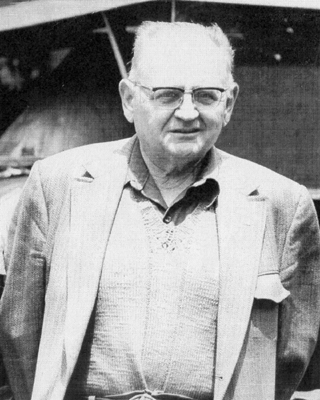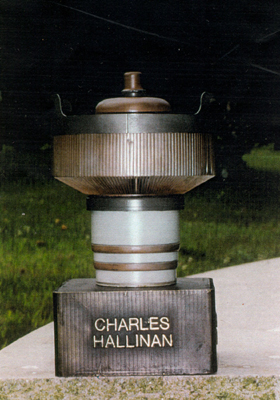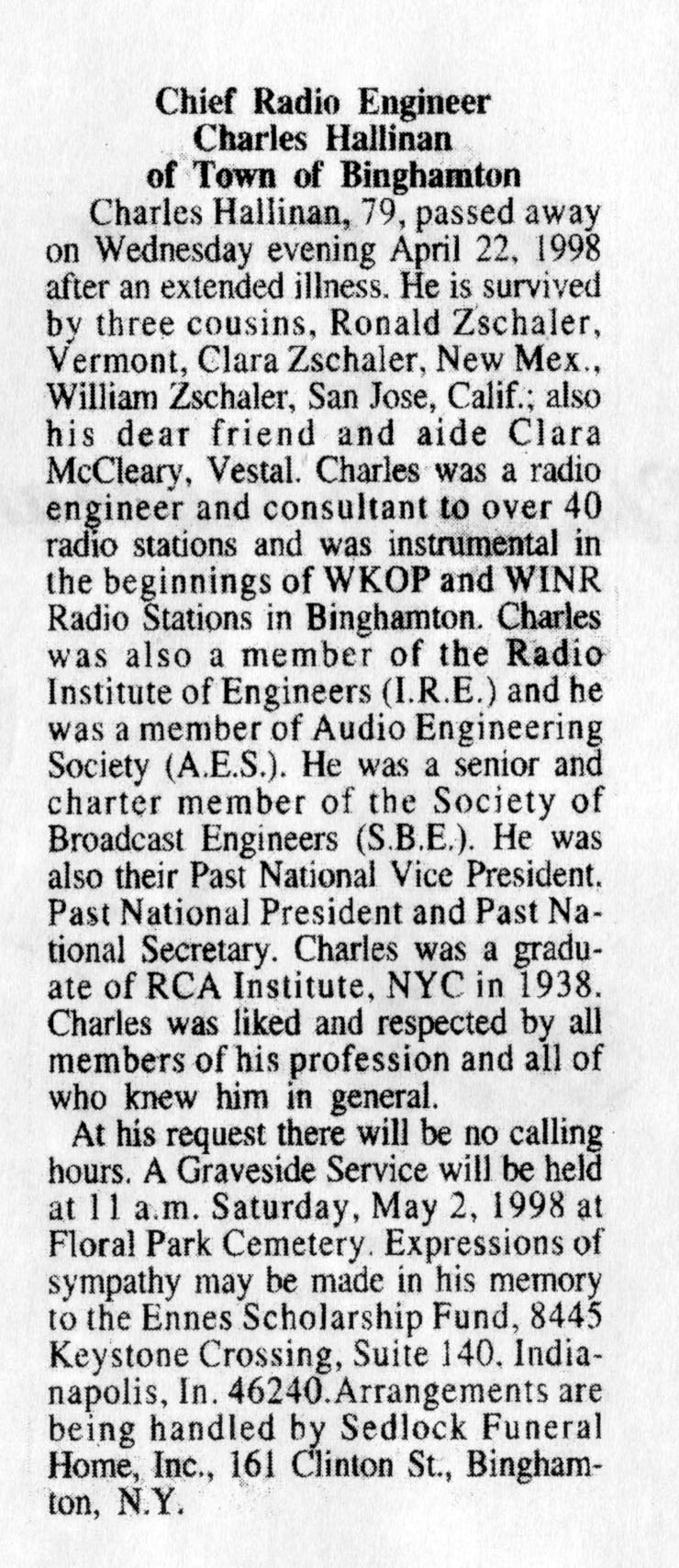Charles Hallinan
The Life and Times of a Tube Man
By Thomas G Siglin
 Charlie Hallinan grew up in downstate
near New York City. His first acquaintance with radio was in the tavern
his parents owned. In an effort to improve the business Charlie’s father
commissioned a radio to be built in the hopes of attracting customers.
The project was successful in that the radio was finished and Charlie recalls
it playing in the bar room. This early version was probably a TRF design
and drove a horn speaker at listenable volumes. Radio being a specialized
field at the time, required an engineer to be brought in to control this
new contraption! Charlie was forbidden from even touching the new toy!
Nevertheless, this introduction to the field of radio would set the stage
for his future in the field.
Charlie continued his involvement with
technology by attending RCA institute in New York City. He completed his
studies by taking the FCC radio test. He was proud to have passed the exam
and related to me the part of the test where he had to draw a schematic
of a complete AM transmitter, from oscillator, modulator to the RF stages.
This was not the time of the multiple choice (or multiple guess tests in
Charlie’s words).
His graduation into the field of electronics
occurred at the startup of World War II. He was called up and put his new
knowledge to work as a radio inspector. He was assigned to quality check
parts and equipment at General Electric in Schenectady New York and other
locations in New York and Pennsylvania. I think he thoroughly enjoyed himself
working in the radio and manufacturing field at this young age. He stayed
in this job until the end of the war when he took advantage of the situation,
starting to accumulate excess parts and materials that were no longer needed
for manufacturing. He loaded a friend’s car up with surplus radio parts
and headed toward Binghamton NY. Later he would use these parts in the
construction of WKOP – AM.
Charlie’s early radio days in Binghamton
were involved with several of the local stations but he settled in at WKOP.
An engineer’s duties of the day were not just maintenance of the equipment.
He actually had a hand in physically constructing the transmitter building
on the hill. This facility at one time was both the transmitter and studios
of the station. Charlie was stay at this upstart station until his retirement.
When the station management decided to get involved in FM, he had a hand
in that project as well.
One story I recall was Charlie’s method
of determining a problem antenna radiator at the FM station. The antenna
design in use at that time consisted of many individual antenna elements
fed by a phasing harness. This particular design apparently had problems
and he would climb the tower with a florescent lamp to check the relative
power being radiated from each section. This technique today would
make most engineers cringe just from the thought of the RF energy levels
the body was subjected to in the process of the test.
Charlie married and settled in at his
home just down the road from the WKOP – AM transmitter. With no children,
they practiced a bit of dairy farming, gardening and led an uncomplicated
life in Binghamton until the death of his wife from heart complications.
The 30-year absence of anyone to constrain Charlie in his habits led to
an interesting development. He had a deep passion for collecting and soon
the house he lived became filled with electronic equipment and radio station
cast-offs. This continued until he made friends with women, Clair, who
persuaded Charlie to repent and give up some of his collecting habits.
The rooms of the house slowly started to yield up treasures of his working
days to become usable for their intended purposes. Most of the items stored
away were from the tube era. Charlie liked tubes and had little love or
appreciation for solid state equipment. He liked tubes so much that I threatened
to throw some tube in his grave when he died, just to keep him warm!
It was on the second walkthrough that
I noticed an odd looking item. It turned out to be a Hallicrafters dual
diversity receiver that was purchased from a friend living near New York
City. The radio needed a new home and Charlie obliged. I asked him what
he was going to do with it and he replied it had to go but he was not going
to give it away. So… a monthly payment arrangement was made and I made
plans for my new toy. Charlie had succeeded in infecting me with his collecting
habit.
Due to complication from old age and diabetes,
Charlie spent the last couple of years of his life in and out of the hospital
and nursing home. On SBE meeting days, friends would spirit him away to
the meeting and back. Since his early days as one of the founders of SBE,
he had a great love for the group and spent a lot of time trying to improve
or change the organization to conform to his ideas. However, SBE had outgrown
the bounds of his personal control and grew on its own under new leadership.
Charlie died on ~ and his last wishes
were to have a simple burial with few or no attendees. Many of his friends
fought that plan and persuaded his executor to have at least a memorial
service to say good bye to a friend and fellow engineer. My plan for Charlie’s
local burial was to toss in a couple of 6L6 tubes but a cousin took control
of his final arrangements and left town with the body. The new intentions
were to place him at a family site in Westchester County of NY State. That
was the last we thought we would ever hear of him: Until I received a call
from his cousin. It seemed Charlie had been cremated and the cousin was
looking for a suitable urn for his ashes. The cousin attempted to have
a radio bronzed for the purpose but that did not work out. I explained
my parting shot of burying some radio tubes with Charlie as a tribute to
his love for them when the idea of actually placing his ashes in a tube
came up. I contacted Econco tube rebuilders in Utah asking for a dud that
was large enough for the purpose. (Econco is now located in Woodland, CA)
My request was met with less than belief but they said it would be considered.
In what seemed like only minutes Econco called back wanting to know where
to send the tube. It was shipped to another of cousin in California, an
artist, that commissioned a base to be made for the tube outlining
a few details of Charlie's life. Charlie was placed into the tube; it was
epoxied shut and mounted on the base.
His final resting-place is in a cemetery
in downstate New York. Charlie was finally at peace.
Charlie Hallinan grew up in downstate
near New York City. His first acquaintance with radio was in the tavern
his parents owned. In an effort to improve the business Charlie’s father
commissioned a radio to be built in the hopes of attracting customers.
The project was successful in that the radio was finished and Charlie recalls
it playing in the bar room. This early version was probably a TRF design
and drove a horn speaker at listenable volumes. Radio being a specialized
field at the time, required an engineer to be brought in to control this
new contraption! Charlie was forbidden from even touching the new toy!
Nevertheless, this introduction to the field of radio would set the stage
for his future in the field.
Charlie continued his involvement with
technology by attending RCA institute in New York City. He completed his
studies by taking the FCC radio test. He was proud to have passed the exam
and related to me the part of the test where he had to draw a schematic
of a complete AM transmitter, from oscillator, modulator to the RF stages.
This was not the time of the multiple choice (or multiple guess tests in
Charlie’s words).
His graduation into the field of electronics
occurred at the startup of World War II. He was called up and put his new
knowledge to work as a radio inspector. He was assigned to quality check
parts and equipment at General Electric in Schenectady New York and other
locations in New York and Pennsylvania. I think he thoroughly enjoyed himself
working in the radio and manufacturing field at this young age. He stayed
in this job until the end of the war when he took advantage of the situation,
starting to accumulate excess parts and materials that were no longer needed
for manufacturing. He loaded a friend’s car up with surplus radio parts
and headed toward Binghamton NY. Later he would use these parts in the
construction of WKOP – AM.
Charlie’s early radio days in Binghamton
were involved with several of the local stations but he settled in at WKOP.
An engineer’s duties of the day were not just maintenance of the equipment.
He actually had a hand in physically constructing the transmitter building
on the hill. This facility at one time was both the transmitter and studios
of the station. Charlie was stay at this upstart station until his retirement.
When the station management decided to get involved in FM, he had a hand
in that project as well.
One story I recall was Charlie’s method
of determining a problem antenna radiator at the FM station. The antenna
design in use at that time consisted of many individual antenna elements
fed by a phasing harness. This particular design apparently had problems
and he would climb the tower with a florescent lamp to check the relative
power being radiated from each section. This technique today would
make most engineers cringe just from the thought of the RF energy levels
the body was subjected to in the process of the test.
Charlie married and settled in at his
home just down the road from the WKOP – AM transmitter. With no children,
they practiced a bit of dairy farming, gardening and led an uncomplicated
life in Binghamton until the death of his wife from heart complications.
The 30-year absence of anyone to constrain Charlie in his habits led to
an interesting development. He had a deep passion for collecting and soon
the house he lived became filled with electronic equipment and radio station
cast-offs. This continued until he made friends with women, Clair, who
persuaded Charlie to repent and give up some of his collecting habits.
The rooms of the house slowly started to yield up treasures of his working
days to become usable for their intended purposes. Most of the items stored
away were from the tube era. Charlie liked tubes and had little love or
appreciation for solid state equipment. He liked tubes so much that I threatened
to throw some tube in his grave when he died, just to keep him warm!
It was on the second walkthrough that
I noticed an odd looking item. It turned out to be a Hallicrafters dual
diversity receiver that was purchased from a friend living near New York
City. The radio needed a new home and Charlie obliged. I asked him what
he was going to do with it and he replied it had to go but he was not going
to give it away. So… a monthly payment arrangement was made and I made
plans for my new toy. Charlie had succeeded in infecting me with his collecting
habit.
Due to complication from old age and diabetes,
Charlie spent the last couple of years of his life in and out of the hospital
and nursing home. On SBE meeting days, friends would spirit him away to
the meeting and back. Since his early days as one of the founders of SBE,
he had a great love for the group and spent a lot of time trying to improve
or change the organization to conform to his ideas. However, SBE had outgrown
the bounds of his personal control and grew on its own under new leadership.
Charlie died on ~ and his last wishes
were to have a simple burial with few or no attendees. Many of his friends
fought that plan and persuaded his executor to have at least a memorial
service to say good bye to a friend and fellow engineer. My plan for Charlie’s
local burial was to toss in a couple of 6L6 tubes but a cousin took control
of his final arrangements and left town with the body. The new intentions
were to place him at a family site in Westchester County of NY State. That
was the last we thought we would ever hear of him: Until I received a call
from his cousin. It seemed Charlie had been cremated and the cousin was
looking for a suitable urn for his ashes. The cousin attempted to have
a radio bronzed for the purpose but that did not work out. I explained
my parting shot of burying some radio tubes with Charlie as a tribute to
his love for them when the idea of actually placing his ashes in a tube
came up. I contacted Econco tube rebuilders in Utah asking for a dud that
was large enough for the purpose. (Econco is now located in Woodland, CA)
My request was met with less than belief but they said it would be considered.
In what seemed like only minutes Econco called back wanting to know where
to send the tube. It was shipped to another of cousin in California, an
artist, that commissioned a base to be made for the tube outlining
a few details of Charlie's life. Charlie was placed into the tube; it was
epoxied shut and mounted on the base.
His final resting-place is in a cemetery
in downstate New York. Charlie was finally at peace.
-
Additional information about Charlie can
be found at:
-
http://www.broadcast.net/~sbe1/history/ch1hist.htm
|



